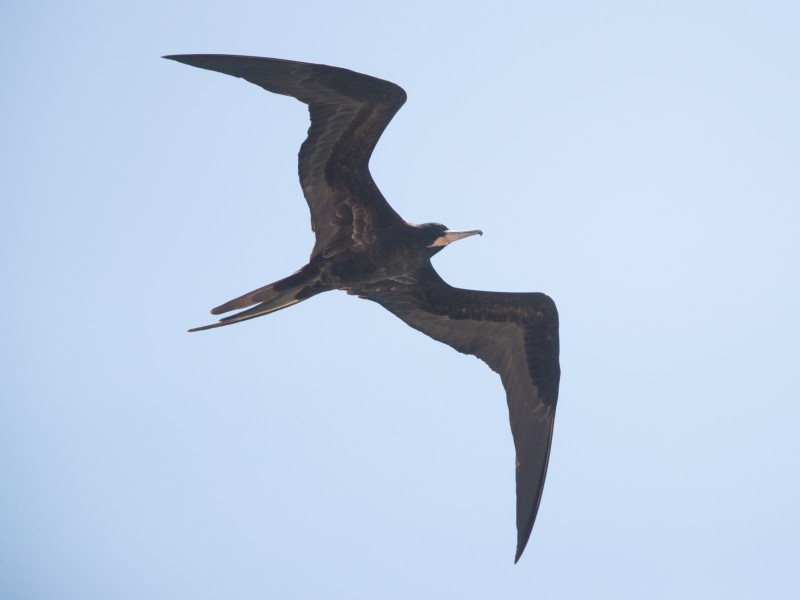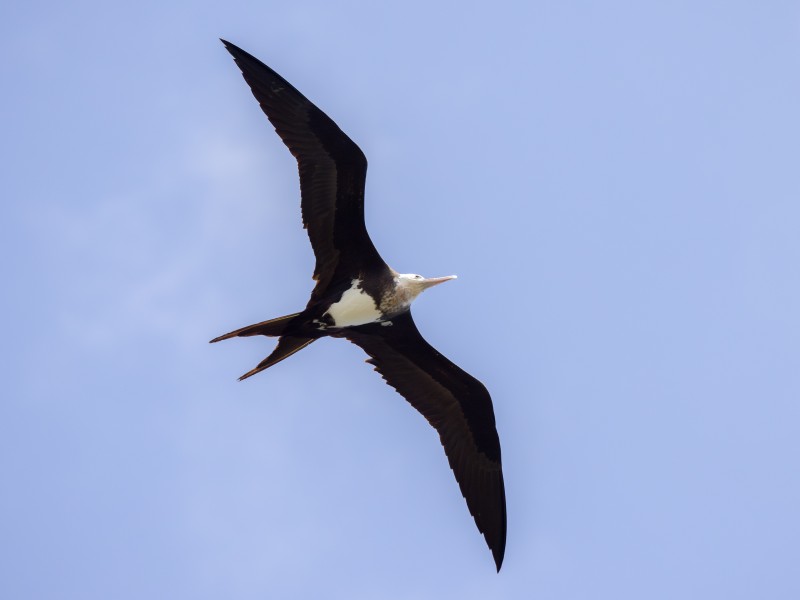Great Frigatebird Fregata minor 黑腹軍艦鳥
Category I. Accidental in sea areas; the rarest of the frigatebirds in HK.
IDENTIFICATION
Identification of frigatebirds is complex, and the full variation cannot be covered here. Readers are referred for further details to James (2004), from which the following is taken.

October, Indonesia. Yann Muzika. Adult male.
85-105 cm. Adult males have all dark underparts, no axillary spurs, weak or absent alar bars; 4th year birds (presumably that illustrated) differ only in white mottling on breast. Third-year males have black belly point, but no axillary spurs or breast tabs. Second-year males have mottled outline of black belly point, moderate buff alar bars but no breast tabs or axillary spurs.

July, Hawaii. Yann Muzika. Juvenile.
Juveniles have an elliptical white belly patch, and 30% of birds have axillary spurs that originate well behind line of breast band.
Third-year females have black ring around neck, mottled black point on lower belly, prominent triangular axillary spurs but no breast tabs. Older females have black throat, distinct white hind collar, black point on belly, axillary spurs that are white, triangular and angle outwards, moderate alar bars. 4th years have white mottling on head.
VOCALISATIONS
Usually silent at sea (Gauger Metz and Schreiber 2020).
DISTRIBUTION & HABITAT PREFERENCE
Records have occurred at sea or in inshore waters.
OCCURRENCE
There are four records from 14 April to 20 May.
1985: singles at Tsim Bei Tsui on 14 April and Rocky Harbour on 5 May.
1987: two in west Lamma Channel on 20 May.
2008: one south of Lamma on 27 April.
BEHAVIOUR, FORAGING & DIET
No observations.
RANGE & SYSTEMATICS
Breeds on islands in tropical and subtropical seas, largely in the Indian and Pacific Oceans, particularly the western and central Pacific; disperses at sea in non-breeding season (Gauger Metz and Schreiber 2020). In China occurs rarely in sea areas as far north as the Bay of Bohai (Liu and Chen 2021).
Five subspecies are recognised of which the nominate breeds from the central Indian Ocean to the South China Sea and is presumed to occur in HK. F. m. palmerstoni occurs in the west and central Pacific, while the remaining three subspecies are more distantly distributed.
CONSERVATION STATUS
IUCN: Least Concern. Population trend decreasing.
Gauger Metz, V. H. and E. A. Schreiber (2020). Great Frigatebird (Fregata minor), version 1.0. In Birds of the World (S. M. Billerman, Editor). Cornell Lab of Ornithology, Ithaca, NY, USA. https://doi.org/10.2173/bow.grefri.01
James, D. J. (2004). Identification of Christmas Island, Great and Lesser Frigatebirds. BirdingASIA 1 (2004): 22-38.
Liu, Y. and S. H. Chen (eds) (2021). The CNG Field Guide to the Birds of China (in Chinese). Hunan Science and Technology Publication House, Changsha.

